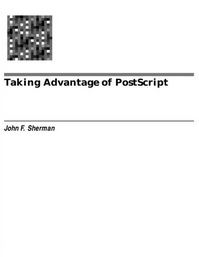
|
FreeComputerBooks.com
Links to Free Computer, Mathematics, Technical Books all over the World
|
|
- Title: Taking Advantage of Postscript
- Author(s) John F. Sherman
- Publisher: William C Brown Pub (August 1991)
- Paperback: 326 pages
- eBook: HTML, PDF, ePub, Kindle, Daisy, DjVu, etc.
- Language: English
- ISBN-10/ASIN: 0697140326
- ISBN-13: 978-0697140326
- Share This:

|
This book will introduce PostScript concepts and drawing techniques. It will cover advanced PostScript techniques that unleash the power of the PostScript Page Description Language. Much of what is covered here cannot be accomplished in available graphics software.
For anyone whose work requires sophisticated text and graphic output--programmers and developers who need to harness PostScript's full capabilities, as well as end users who want to improve the output of desktop publishing packages.
About the Authors- N/A
- PostScript Programming
- Tex, LaTeX and AMS-LaTeX
- Algebra, Abstract Algebra, and Linear Algebra
- Mathematics
 Similar Books:
Similar Books:
-
 PostScript Language: Tutorial and Cookbook
PostScript Language: Tutorial and Cookbook
This book provides a step-by-step guided tour of PostScript, highlighting those qualities that make it such a unique and powerful language. It offers a collection of some of the most useful techniques and procedures available to PostScript programmers.
-
 Mathematical Illustrations: A Manual of Geometry and PostScript
Mathematical Illustrations: A Manual of Geometry and PostScript
It combines a completely self-contained step-by-step introduction to the graphics programming language PostScript with an analysis of the requirements of good mathematical illustrations, for anyone with basic knowledge of coordinate geometry.
-
 Thinking in Postscript (Glenn C. Reid)
Thinking in Postscript (Glenn C. Reid)
This hands-on guide shows readers how to "think" in PostScript, providing both new and experienced PostScript programmers with ideas and techniques to better manipulate and optimize PostScript functions and features.
-
 PostScript Language Program Design (Glenn C. Reid)
PostScript Language Program Design (Glenn C. Reid)
This book teaches the programming principles that are unique to the PostScript language with numerous, usable sample programs throughout. Setting text; writing emulators; constructing graphics; debugging programs, and more.





